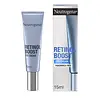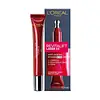What's inside
What's inside
 Key Ingredients
Key Ingredients

 Benefits
Benefits

 Concerns
Concerns

 Ingredients Side-by-side
Ingredients Side-by-side

Water
Skin ConditioningPentaerythrityl Tetraethylhexanoate
EmollientDimethicone
EmollientGlycerin
HumectantPPG-15 Stearyl Ether
EmollientStearyl Alcohol
EmollientCetearyl Alcohol
EmollientButylene Glycol
HumectantCeteareth-20
CleansingIsohexadecane
EmollientRetinol
Skin ConditioningHydrolyzed Myrtus Communis Leaf Extract
Skin ProtectingCaprylic/Capric Triglyceride
MaskingEthylhexylglycerin
Skin ConditioningSodium Hyaluronate
HumectantCaprylyl Glycol
EmollientPolyacrylamide
Cellulose
AbsorbentC13-14 Isoparaffin
EmollientLaureth-7
EmulsifyingDimethicone Crosspolymer
Emulsion StabilisingAmmonium Acryloyldimethyltaurate/Vp Copolymer
Disodium EDTA
Sodium Hydroxide
BufferingBHT
AntioxidantAscorbic Acid
AntioxidantPhenoxyethanol
PreservativeChlorphenesin
AntimicrobialWater, Pentaerythrityl Tetraethylhexanoate, Dimethicone, Glycerin, PPG-15 Stearyl Ether, Stearyl Alcohol, Cetearyl Alcohol, Butylene Glycol, Ceteareth-20, Isohexadecane, Retinol, Hydrolyzed Myrtus Communis Leaf Extract, Caprylic/Capric Triglyceride, Ethylhexylglycerin, Sodium Hyaluronate, Caprylyl Glycol, Polyacrylamide, Cellulose, C13-14 Isoparaffin, Laureth-7, Dimethicone Crosspolymer, Ammonium Acryloyldimethyltaurate/Vp Copolymer, Disodium EDTA, Sodium Hydroxide, BHT, Ascorbic Acid, Phenoxyethanol, Chlorphenesin
Water
Skin ConditioningDimethicone
EmollientGlycerin
HumectantSilica
AbrasiveAcrylamide/Sodium Acryloyldimethyltaurate Copolymer
Emulsion StabilisingPrunus Armeniaca Kernel Oil
MaskingTriethanolamine
BufferingDimethicone/Vinyl Dimethicone Crosspolymer
Skin ConditioningDimethiconol
EmollientCaffeine
Skin ConditioningIsohexadecane
EmollientAdenosine
Skin ConditioningDisodium EDTA
Propylene Glycol
HumectantHydrolyzed Hyaluronic Acid
HumectantHydroxyethylpiperazine Ethane Sulfonic Acid
BufferingHydroxypropyl Tetrahydropyrantriol
Skin ConditioningPolysorbate 80
EmulsifyingAcrylates/C10-30 Alkyl Acrylate Crosspolymer
Emulsion StabilisingTocopheryl Acetate
AntioxidantPhenoxyethanol
PreservativeChlorphenesin
AntimicrobialCI 77891
Cosmetic ColorantMica
Cosmetic ColorantWater, Dimethicone, Glycerin, Silica, Acrylamide/Sodium Acryloyldimethyltaurate Copolymer, Prunus Armeniaca Kernel Oil, Triethanolamine, Dimethicone/Vinyl Dimethicone Crosspolymer, Dimethiconol, Caffeine, Isohexadecane, Adenosine, Disodium EDTA, Propylene Glycol, Hydrolyzed Hyaluronic Acid, Hydroxyethylpiperazine Ethane Sulfonic Acid, Hydroxypropyl Tetrahydropyrantriol, Polysorbate 80, Acrylates/C10-30 Alkyl Acrylate Crosspolymer, Tocopheryl Acetate, Phenoxyethanol, Chlorphenesin, CI 77891, Mica
Ingredients Explained
These ingredients are found in both products.
Ingredients higher up in an ingredient list are typically present in a larger amount.
Chlorphenesin is a synthetic preservative. It helps protect a product against bacteria in order to extend shelf life. In most cases, Chlorphenesin is paired with other preservatives such as phenoxyethanol and caprylyl glycol.
Chlorphenesin is a biocide. This means it is able to help fight the microorganisms on our skin. It is also able to fight odor-releasing bacteria.
Chlorphenesin is soluble in both water and glycerin.
Studies show Chlorphenesin is easily absorbed by our skin. You should speak with a skincare professional if you have concerns about using Chlorphenesin.
Learn more about ChlorphenesinDimethicone is a type of synthetic silicone created from natural materials such as quartz.
What it does:
Dimethicone comes in different viscosities:
Depending on the viscosity, dimethicone has different properties.
Ingredients lists don't always show which type is used, so we recommend reaching out to the brand if you have questions about the viscosity.
This ingredient is unlikely to cause irritation because it does not get absorbed into skin. However, people with silicone allergies should be careful about using this ingredient.
Note: Dimethicone may contribute to pilling. This is because it is not oil or water soluble, so pilling may occur when layered with products. When mixed with heavy oils in a formula, the outcome is also quite greasy.
Learn more about DimethiconeDisodium EDTA plays a role in making products more stable by aiding other preservatives.
It is a chelating agent, meaning it neutralizes metal ions that may be found in a product.
Disodium EDTA is a salt of edetic acid and is found to be safe in cosmetic ingredients.
Learn more about Disodium EDTAGlycerin is already naturally found in your skin. It helps moisturize and protect your skin.
A study from 2016 found glycerin to be more effective as a humectant than AHAs and hyaluronic acid.
As a humectant, it helps the skin stay hydrated by pulling moisture to your skin. The low molecular weight of glycerin allows it to pull moisture into the deeper layers of your skin.
Hydrated skin improves your skin barrier; Your skin barrier helps protect against irritants and bacteria.
Glycerin has also been found to have antimicrobial and antiviral properties. Due to these properties, glycerin is often used in wound and burn treatments.
In cosmetics, glycerin is usually derived from plants such as soybean or palm. However, it can also be sourced from animals, such as tallow or animal fat.
This ingredient is organic, colorless, odorless, and non-toxic.
Glycerin is the name for this ingredient in American English. British English uses Glycerol/Glycerine.
Learn more about GlycerinIsohexadecane is added to enhance texture, emulsify, and to help cleanse. It is an isoparrafin. It is a component of petrolatum.
Due to its large size, Isohexadecane is not absorbed by the skin. Instead, it sits on top and acts as an emollient. Emollients help keep your skin soft and smooth by trapping moisture within.
Isohexadecane is often used in products designed to help oily skin. It is lightweight and non-greasy while helping to moisturize. When mixed with silicones, it gives a product a silky feel.
Learn more about IsohexadecanePhenoxyethanol is a preservative that has germicide, antimicrobial, and aromatic properties. Studies show that phenoxyethanol can prevent microbial growth. By itself, it has a scent that is similar to that of a rose.
It's often used in formulations along with Caprylyl Glycol to preserve the shelf life of products.
Water. It's the most common cosmetic ingredient of all. You'll usually see it at the top of ingredient lists, meaning that it makes up the largest part of the product.
So why is it so popular? Water most often acts as a solvent - this means that it helps dissolve other ingredients into the formulation.
You'll also recognize water as that liquid we all need to stay alive. If you see this, drink a glass of water. Stay hydrated!
Learn more about Water